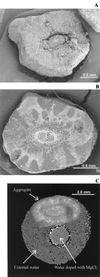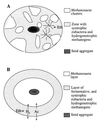Cluster structure of anaerobic aggregates of an expanded granular sludge bed reactor
- PMID: 11472948
- PMCID: PMC93072
- DOI: 10.1128/AEM.67.8.3683-3692.2001
Cluster structure of anaerobic aggregates of an expanded granular sludge bed reactor
Abstract
The metabolic properties and ultrastructure of mesophilic aggregates from a full-scale expanded granular sludge bed reactor treating brewery wastewater are described. The aggregates had a very high methanogenic activity on acetate (17.19 mmol of CH(4)/g of volatile suspended solids [VSS].day or 1.1 g of CH(4) chemical oxygen demand/g of VSS.day). Fluorescent in situ hybridization using 16S rRNA probes of crushed granules showed that 70 and 30% of the cells belonged to the archaebacterial and eubacterial domains, respectively. The spherical aggregates were black but contained numerous whitish spots on their surfaces. Cross-sectioning these aggregates revealed that the white spots appeared to be white clusters embedded in a black matrix. The white clusters were found to develop simultaneously with the increase in diameter. Energy-dispersed X-ray analysis and back-scattered electron microscopy showed that the whitish clusters contained mainly organic matter and no inorganic calcium precipitates. The white clusters had a higher density than the black matrix, as evidenced by the denser cell arrangement observed by high-magnification electron microscopy and the significantly higher effective diffusion coefficient determined by nuclear magnetic resonance imaging. High-magnification electron microscopy indicated a segregation of acetate-utilizing methanogens (Methanosaeta spp.) in the white clusters from syntrophic species and hydrogenotrophic methanogens (Methanobacterium-like and Methanospirillum-like organisms) in the black matrix. A number of physical and microbial ecology reasons for the observed structure are proposed, including the advantage of segregation for high-rate degradation of syntrophic substrates.
Figures






References
-
- American Public Health Association. Standard methods for examination of water and wastewater. 16th ed. Washington, D.C.: American Public Health Association; 1985.
-
- Colleran E, Concannon F, Golden T, Geoghegan F, Crumlish B, Killilea E, Henry M, Coates J. Use of methanogenic activity test to characterize anaerobic sludges, screen for anaerobic biodegradability and determine toxicity thresholds against individual anaerobic trophic groups and species. Water Sci Technol. 1992;25:31–40.
-
- Davies D G, Parsek M R, Pearson J P, Iglewski B H, Costerton J W, Greenberg E P. The involvement of cell-to-cell signals in the development of a bacterial biofilm. Science. 1998;280:295–298. - PubMed
Publication types
MeSH terms
Substances
LinkOut - more resources
Full Text Sources
Miscellaneous

